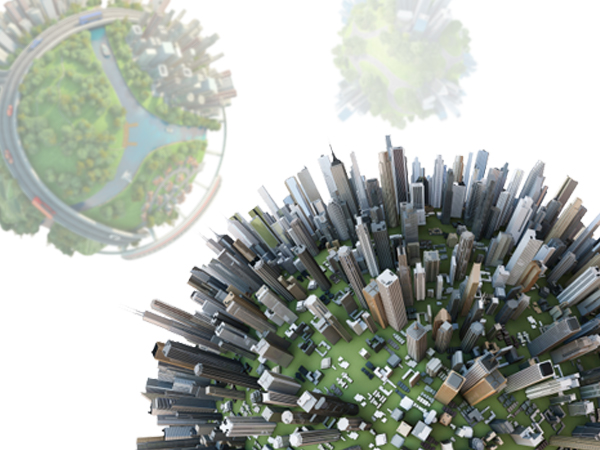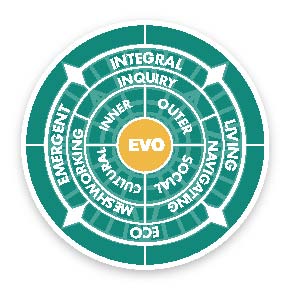Humans and the cities we have created are permanently locked into a never-ending learning cycle, to create ever more complex adaptations to protect increasingly more complex cities.
In the Integral City 2.0 Online Conference (2012), five critical threats to human populations in cities were identified: climate, energy, water, food and finance (Hamilton et al., 2013; Hamilton and Sanders, 2013). These threats, are deeply interconnected and must be viewed within a systemic framework that considers all five sets of intelligences in cities – Contextual, Integral (Individual/Collective), Strategic and Evolutionary.
In keeping with my contemplation of the Nattrass article “How ARE we to go on together: Our Evolutionary Crossroads” I want to consider the story we tell ourselves about climate – and how that story may be increasing the dissonance we (as a species) are experiencing as individuals, organizations, cities and the planet.
I propose that the growing magnitude of this dissonance about climate change is exactly what we need in order to make a significant leap in our collective worldviews about climate change.
The Nattrasses bring this dissonance sharply to mind as they reflect on the increasingly anxious questions that have emerged since our early doubts about human relationship to Nature (a form of Collective Intelligence). They ask (as could our mothers too).
- Is humanity bankrupting nature?
- Is humanity on a collision course with the natural world?
- What is our ecological footprint?
- What are ecosystem services and how do we calculate their value?
- Are human activities causing climate change?
- What are the limits to growth on this planet?
- Is there a population bomb ticking?
- Can we meet our needs today and leave enough for future generations to meet theirs as well?
- What does it mean to overshoot ecological capacity?
However, the integral perspective on the cycle of human learning (well explored by Clare Graves) observes that why humans learn depends on precisely their encounters/relationships with dissonance. Without experiencing dissonance we essentially are not motivated to change and so we don’t change!
Many believe that the greatest dissonance the globe faces today is climate change. It is impacting all life forms, including ours. The disturbing situation is though, that we cannot definitively say what is causing climate change? But however, we define the causal equation it appears that human behavior is a contributing factor. And commensurately human intelligence is required to mitigate, adapt and if possible prevent it.
Climate is inescapably a prime element of the habitats in which we live – including and probably especially cities. As individuals we co-exist with our habitats from the smallest personal social scales (Map 2) to the largest Kosmic scales (Map 4, Map 5). Within these inner and outer spectra of human groupings (Map 2) and environmental contexts, we co-create and co-evolve with our habitats.
Earlier in this 21st century cities became the habitats of 50%+ of humanity (90% in developed world). Cities are the most complex human system yet created. As social holons they are complex adaptive systems with potential for orders of learning that magnify the intelligence of any one individual, family, group, organization, sector or neighbourhood. The Nattrasses (2015) point out:
Virtually any
Cities are containers of holons, social holons, relationships, exchanges and emergents – at every scale. As a whole I have long considered them to be a massively complex meshwork. But in practice cities are actually meshworks of meshworks. [See the full definition of meshworking intelligence here.]
The operational values of meshworks in living systems is that they enable a continuous stream of natural, living complex structures to emerge – so that the living system can make the most efficient use of energy by capturing the structures (and infrastructures) that have enabled survival and sustainability; for example this is how all the structures that enable cities to function have emerged – from family hearths, to clans, kingdoms, bureaucracies, businesses social networks, communications systems and global alliances (Map 4). At the same time effective meshworks ensure that background activity never stops self-organizing – thus enabling creative adaptation and emergence (e.g. the activities of inventors, artists, researchers, entrepreneurs, developers, etc.).
This “natural” meshworking capacity of human systems has never been successfully suppressed in the long run, by any governance system, technology or habitat – because the nature of earthly life has ensured that dissonance is always with us – challenging our hierarchies and demanding new solutions for life-threatening problems. But as the Nattrasses point out, the assumptions and worldviews in the Old Story of how cities work, have entrenched the blindness to the impact of human influence on climate change (whatever the cause) into the very organs (organizations) of the living city itself.
The bad news is that cities converge all the problems and potentials of humanity into a vortex of toxic threats. The good news is that cities converge all the problems and potentials of humanity into a spiral of dissonances that trigger the emergence of possibilities and intelligences. (In fact I have suggested that Integral Cities that are alive, resilient and optimized operate with a suite of 12 intelligences (in 5 sets).)
The dissonances caused by climate change challenge all five sets of city intelligences: Contexting/ Integral – Individual and Collective /Strategic/ Evolutionary.
As we are waking up to the very real threats of climate change to our cities, our 4 city Voices act like clumsy children who are not yet effective managers of their bio/psycho/cultural/social capacities. As cities we are bumbling around – but, because we are noticing that the Old Story of the mechanical city does not answer all the questions that arise, our dissonances are thrown back in our collective face(s). In other words, our city habitats let us know in very real terms when our learning is not sufficient to the task at hand.
As Brian and Mary Nattrass point out, we have come to a place on this planet where we have never been before. As a species who has hardly reached our teenagehood, we long for parents who might give us another story to explain life.
Rio, Kyoto, Seattle, Copenhagen, Paris
But, cities as the most complex human system we have yet created are discovering that we will have to parent ourselves. One by one cities are learning the hard lessons and bit by bit, we are teaching the human systems within our cities the difficult learning lessons of climate change pioneers. By extension these cities on the early-change bandwagon are beginning to share their hard lessons with our planet of cities – as each becomes ready to learn (i.e. when the dissonance meter gets loud enough, such as happened in New Orleans and Sendai).
As the clarion call for climate change awareness has sounded now for more than a quarter century, the early storytellers of this New Story have despaired at what has seemed collective deafness. They expected nations and organizations to take the lead. But now we see that it is perhaps not surprising that cities have taken the lead, and continue to be at the forefront of storytellers of a different way.
Cities as convergences of human capacities have the most to lose by not addressing climate change. They sit at the nexus points of Earth’s greatest tectonic contractions, water flows, air sheds, food production, energy consumption and material production. And they also concentrate the greatest quantity of evolutionary intelligence to focus on the problems at hand.
Many early adopters have agonized over the apparent resistance of organizations to respond effectively (or at all) to climate change. But by definition successful organizations have not only been anchored in the Old Story – they have verified it, sustained it and perpetuated it (as the Nattrasses noted above).
But with the lenses of complexity, living systems and evolutionary wholeness, we realize that cities are a more complex order of human systems than organizations. Cities are effectively organizations of organizations. And that is why a meshwork (discussed above) is the (fractal) explanation of how they become effective at working together.
So now that our cities have woken up and see strategies for climate change, what role can cities play in changing the story of climate change? More precisely what roles can the 4 Voices of the city working together play in transitioning from the Old Story to the New Story?
Citizens can:
- Ask the tough questions
- Keep wellbeing in mind
- Practise the Master Code
Civic Managers can:
- Connect all the systems inside the city and between cities
- Take Governance initiatives – defy federal/national/global resistances
- Amplify governance initiatives (like Obama’s announcements of US/China Climate Change Agreement)
- Emerge the new structure(s) by prototyping and experimenting. (Like Curitiba building the city for people not cars).
Civil Society can:
- Convene the intelligence/story challengers/researchers for ongoing forums of discovery (Rio, Kyoto, Seattle, Copenhagen, Paris have not been in vein – each convening has moved the story forward).
- Create Metrics and Collect the Indicators – ISO Standard for Cities
- Mediate smaller the effectiveness and capacity of all scales – both those smaller than cities such as organizations and those larger scales like nations and the planet itself
Developers, Researchers and Business can:
- Prototype change
- Align organizations of organizations – learn how to meshwork with intention
- Keep the meshwork a living, intentional capacity building process.
A final word from Brian and Mary Nattrass:
In the thousands of years of remembered human histories, it has been expressed in many ways in many times among many peoples that we are that being who lives between Heaven and Earth—ever torn between the god-like qualities of our highest selves and the bestial qualities of our animal selves. Never in our history as a species have we been so urgently called to live and be inspired by the qualities of our better natures; and to grow beyond the tug of our weaker selves. This is a challenge for us as individuals just as much as for our organizations and our society—because ultimately, our organizations and our societies are only expressions of us. So we come now to our evolutionary challenge—the very real challenge of our time. It is the story we are still writing together. It is that socially negotiated story that will ultimately answer the question: How are we to go on together?
It is my contention that key cities are at the stage of evolution where the dissonances they are experiencing have awakened them to being proactive on their own behalf and on behalf of the planet of cities. These cities who are early adopters of the New Integral City story are creating the habitats that will enable us all to go on together.
References
Graves, C. (2005). The Never Ending Quest: A Treatise on an Emergent Cyclical Conception of Adult Behavioral Systems and Their Development. Santa Barbara, CA: ECLET Publishing.
Hamilton, M. (2008). Integral City: Evolutionary Intelligences for the Human Hive. Gabriola Island BC: New Society Publishers.
Hamilton, M., & Sanders, B. (2013). Integral City 2.0 Online Conference 2012 Proceedings: A Radically Optimistic Inquiry Into Operating System 2.0 M. Hamilton (Ed.) Retrieved from http://www.scribd.com/doc/120713339/Integral-City-2-0-Online-Conference-2012-A-Radically-Optimistic-Inquiry-into-Operating-System-2-0
Hamilton, M., & etal. (2013). Integral City 2.0 Online Conference 2012 Appendices: A Radically Optimistic Inquiry Into Operating System 2.0 – 36 Interviews M. Hamilton (Ed.) Retrieved from http://www.scribd.com/doc/123005653/Integral-City-2-0-Online-Conference-2012-Appendices-A-Radically-Optimistic-Inquiry-into-Operating-System-2-0-36-Interviews
Nattrass, B., & Nattrass, M. (2015). How ARE We To Go On Together? Our Evolutionary Crossroads. Integral Leadership Review January-February (Canada Issue). Retrieved from http://integralleadershipreview.com/12795-215-go-together-evolutionary-crossroads/
This blog is one of a series that explores the relevance and application of ideas to the Integral City, in the articles published in the Integral Leadership Review – Canada Issue, 2015, curated and Guest Edited by Marilyn Hamilton.


Leave A Comment